Flexibility, reliability, value for the dollar-the music lover shopping for a Compact Disc player has never had it so good.
IF you've taken a long time in deciding which Compact Disc player is your "Dream Machine," you may be in for a surprise when you finally go to buy it.
Many of the models available just last year no longer exist. They've been replaced, in most cases, with third- and even fourth-generation equipment that offers more value for the dollar, more feature options, and more variety in size and styling than ever before.
Whether you want just a basic, no-frills machine or a deluxe, fully programmable model, you'll have a lot to choose from, and you can expect to get a lot more for your money. One approach to this happy state of affairs is to upgrade your "wish list," getting more features with the same budget. Another is to buy a machine in the same category you originally intended but to in vest the money you save in a larger initial collection of Compact Discs that you can play on it.
One reason for the unusually rapid developments in CD players is that when the CD format finally caught on, music lovers snapped up so much equipment that many manufacturers sold out their inventories. Instead of then producing more of the same players, they decided to bring out new models incorporating all the technological advances of the past year.
The newer models have also benefited from the economies of scale that manufacturing for a larger market makes possible, thus bringing prices down.
The new CD players are both more convenient and more flexible to use than typical players of the past two years. More of the players have index-point cueing.
They offer more programming and accessing options, faster access to individual tracks, more useful displays and readouts, more reliable drive systems, better error-correction and tracking capabilities, greater resistance to shock and vibration, and better electronics and filtering systems. There are more models with remote controls, and more functions can be controlled remotely. Overall, the music lover shopping for a CD player has never had it so good, and there's no longer much of a valid excuse for not buying one.
-------------
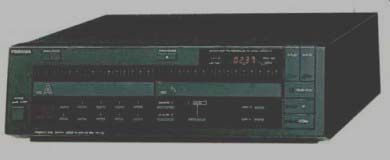
Toshiba’s
XR-V22 can play two CD's in succession or a program of tracks from both discs.
One CD can be changed while the other is playing. $499.95.
----------
----------------
You now have a choice of more features for the same budget, or you can buy a CD player in the same category you originally intended and invest your savings in a larger initial collection of compact Discs to play on it .-------------------
--------------
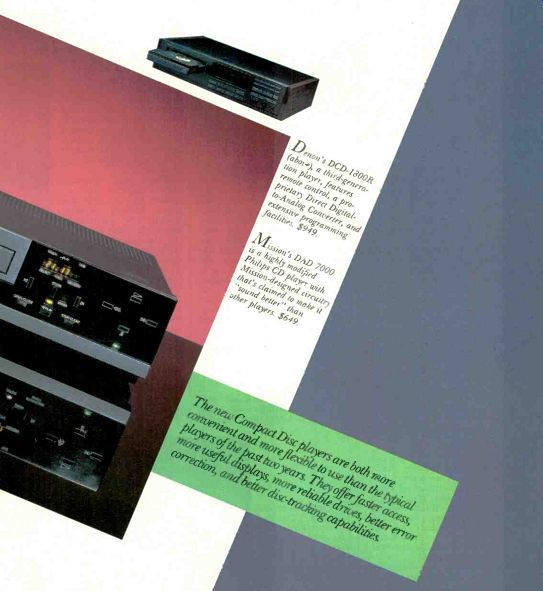
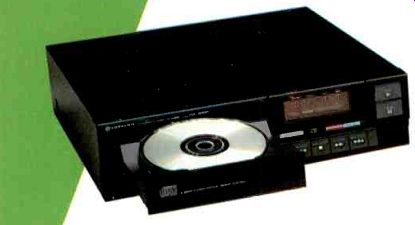
Hitachi's DA-4000 is a mid-sized player with many features, including
skip search and a video-subcode output port for future graphics-programmed
CD's. $400.
-------------
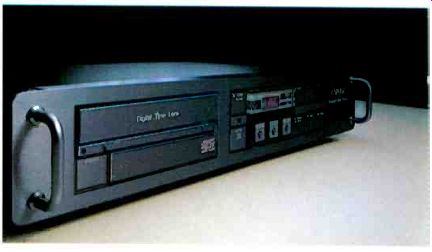
Carver CD player equipped with Carver', proprietary Digital Time Lens,
which boosts the midrange reverberant music content in order to make CD's "sound
less digital." $650.
------------------
While a few recent models have features or characteristics that are unique or outstanding, in general the trend in CD hardware is toward a steady refinement of the existing technology to produce reasonably priced, practical home players. Al though a few manufacturers claim to have produced CD players that "sound better" than previous models, it is advisable to keep such claims in perspective. Except for minor frequency-response differences, all properly operating CD players sound very good-it's in the nature of the format. It is more useful to evaluate CD players in terms of their features.
Remote Control
Quite a few more CD players now come with wireless infrared remote controls-and at lower prices. Last year $600 was the typical price for a remote-controllable CD player. The latest crop has several for substantially less, including Sony's CDP 102 ($450), Pioneer's PD-7010 ($460), Yamaha's CD-3 ($499), Technics' SL-P2 ($500), and Sherwood's CDP-220 ($500).
Last year Sony introduced the first players with wireless remotes incorporating a volume control, the CDP-610ES ($850) and CDP-400 ($800). This year Technics also offers such a remote, for its deluxe SL P3 ($600). Some of the remote controls are pretty basic, with a mini mum of pushbuttons, and there seems to be no relationship between the number of buttons and the player's price. For instance, the $1,295 Nakamichi OMS-7 has a seven-function remote control, while the $600 Technics SL-P3 has a remote with twenty-four keys, ten of them for program selection.
Some remotes just duplicate most of the controls on the player itself, but others have extra controls that are not on the player panel, such as JVC's XLV400 ($430).
Programming
Last year, random-access programming capabilities were avail able in about half of the CD players then in the stores, generally in models priced at $500 and up. Far more of the latest introductions have such capabilities, including about sixty models from some thirty manufacturers. And, as with remote-control features, the starting prices for programmable models are lower, with several at less than $400. Sanyo even offers random-access programming in three models all priced at $299.95, the CD660, CD760, and CD667.
Random-access programming makes it possible for you to play recorded musical selections in the order you want to hear them, rather than in the or der chosen by the disc's producer. I predict that as the technology advances and prices drop even further, CD players offering only straight sequential playback will follow cassette decks without Dolby noise reduction into extinction.
While most programmable machines can sequence between nine and twenty different selections, several new entrants go beyond that limit. For example, Pioneer's new PD-5010 ($300) can program up to twenty seven tracks, and the same company's PD-7010 ($460) and PD-9010X ($540) can each handle up to thirty two programmed selections. Top ping the list in terms of programming capability are the Mission DAD 7000 ($649) and 7000R (with remote, $749), the Kenwood DP 1100II ($635), and Sanyo's CD660, CD667, and CD760, all of which can program up to ninety-nine tracks in any sequence. This impressive capability may be "a feature developed ahead of a market for it," as a Sanyo representative told me, since to my knowledge only CD test discs have that many tracks.
Indexing
Buyers are sometimes confused between programming and indexing. At press time only Mission, Kenwood, and Sanyo models can program up to ninety-nine tracks on a CD for playback in a desired sequence, but several other players can directly access as many as ninety-nine points on a disc using the digitally encoded index numbers inserted by the disc manufacturer. A popular-music or jazz CD might have, say, only ten individual tracks, each consisting of a complete song or instrumental composition, but each of those tracks could have several passages indexed for quick access if desired. Similarly, a classical CD might consist only of a single long work (with or without track breaks between sections), but it could be provided with dozens of index points in order to locate themes, leitmotifs, arias, solo pas sages, and so on.
A CD player's ability to access indexed passages on a disc is thus distinct from its ability to play selected tracks in a desired order.
For example, while Sony's CDP 520ES ($600) and CDP-650ES ($1,300) can be programmed for "only" sixteen tracks, they are capable of locating up to ninety-nine indexed passages, using either the front-panel controls or their remote-control units.
Searching
A skip-search feature was common in last year's CD players, and it seems to be even more popular this year judging from the many 1985 models that provide it. Skip-search buttons offer access to any particular track or index point within a track simply by pressing the button repeatedly until the desired section of the disc is reached. The feature generally operates in both forward and reverse, as in Onkyo's DX-150 ($399) and DX-200 ($699), Nakamichi's OMS-5 ($995) and OMS-7 ($1,295), the rack-mountable Nikko NCD-100 ($799), the Technics SL-P3, SL-P2, and SL-P1 ($400), and Kyocera's DA810 ($1,100).
------------------------

Kenwood's DP-1100II is said to be an improved version of last year's
DP-1100. It has remote control and extensive programming features, including
index search and random access to up to ninety-nine tracks. $635.
---------
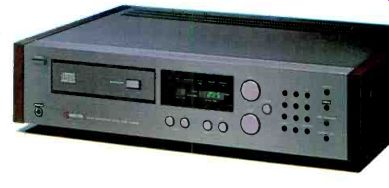
-------- Kyocera's DA-810 uses a D/A converter system with digital filters,
third-order Bessel filters, and independent left- and right-channel D/A converters
for maximum separation and minimum phase error. $1,100. -------
The same capability goes under other names as well, such as Program Skip in Akai's CD-A7 ($600), Self Program Search System in Hitachi's DA-4000 ($400), Music Skip in the Magnavox FD3040SL ($569.95) and the Teac PD-500 ($750), Automatic Program Search System (APSS) in Sharp's DX-600 ($450) and DX-100 ($400), Quick Program Selector in Toshiba's XR V I 1 ($399.95) and XR-V40 ($399.95), and Delete Programming in Marantz's CD-74 ($700) and Sylvania's FDD304SL ($600).
Skip-search can work with other search-and-scan systems. Depress the FAST control in either forward or reverse on the Ultrx CP400 ($700), for example, and the laser pickup will scan across the disc at five times normal speed; after 3 seconds, the scanning speed automatically increases to twenty-two times normal. During scanning the elapsed-program-time counter indicates the pickup's current position within a selection. High-speed search/scanning appears in several other models, including the Carver Compact Disc player ($650), the JVC XLV200 ($299), Kenwood's DP-1100II ($635), the Magnavox FD3040SL, the Marantz CD-64 ($399), McIntosh's MCD 7000 ($1,395), Sherwood's CDP 220, and Sylvania's FDD104SL ($450).
Some search/scan systems automatically stop and play a short sample of the music, ranging from 3 seconds up to 10 seconds or more, as in the Auto Music Scan system of the Marantz CD-74 and the IntroScan system of the Ultrx CP400. The McIntosh MCD 7000 permits a 10-second preview of a disc's content using the Programming Music Scan button on its remote control. Luxman's D-03 ($1,500) and D-405 ($600) also offer automatic 10-second sampling through their Cue/ Review functions, and JVC's XLV500 offers 15-second previewing with its Intro-Scan. The Auto Music Scan in the Technics SL-P2 and SL-P3 permits variable sampling times ranging from a few seconds up to 99 seconds, selected by numbered control keys.
Few of last year's CD players had index-search capability, which lets you command the machine to start playback at a certain index point other than at the beginning of the disc or of a track. The reason was a dearth of CD's with index points encoded on them. More such discs are now available, and more are on the way, so you'll find this feature in many new players. Among them are Teac's PD500, Yamaha's CD-X2 ($400) and CD-3 ($500), Quasar's CD8975 ($400 in a metal cabinet or $425 in a simulated-wood-grain cabinet), Ultrx's CP400, Marantz's CD-74, Sanyo's CD660. 667, and 760, Mission's DAD 7000 and 7000R, Kenwood's DP-1100II, Kyocera's DA-810, Pioneer's PD-701, PD-9010, and P-DX700, and Scott's 949DA ($379.95) and 959DA ($449.95).
Displays
The new CD equipment for 1985 by and large has better display facilities than last year's. For instance, the NEC CD-607E ($599) has six different time displays. It can show the total playing time of the disc, the remaining playing time of the disc, the elapsed time of the disc, the total playing time of the track being played, the remaining playing time of the track, and the elapsed time from the beginning of the track.
In addition to showing track numbers and playing times, some machines display other functions.
The Technics SL-P3, for example, shows the output-level set ting via an LED readout on its panel. The SL-P3, SL-P2, and SL-P1 also feature a Disc Prism, which shows by reflected images in a slot above the disc drawer ...
-----------
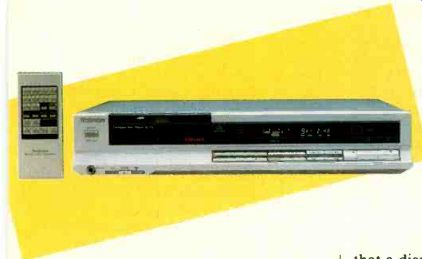
Technics has one of the lowest-priced players with remote control, the
$500 SL-P2. It features a Disc Prism that lets the user see the CD spinning
inside the player, and many other features are also shared with the $600
SL-P3 tested for last month's issue.
--------------------------
...that a disc has been loaded into the player. The Revox B225 ($1,150) has a similar viewing prism.
Headphones
Listening to Compact Discs on headphones is the best way to appreciate them according to many dedicated music lovers. Because headphones can eliminate the extraneous noises that often disturb listening to speakers in typical home surroundings, they are said to ex tract every nuance of the CD format's music-reproduction capability. Accordingly, most manufacturers have equipped their 1985 CD players with front-panel headphone jacks. Some have even gone a welcome step beyond by incorporating separate headphone volume controls next to the jack for more convenient operation. Players with this feature include the Nakamichi OMS-7, NEC CD-607E, Akai CD-A7, JVC XLV500, McIntosh MCD 7000, Luxman D-03 and D-405, Nikko NCD-100, Kenwood DP-1100II, Sony CDP-302, Technics SL-P2 and SL-P3, Toshiba XR-40, Ultrx CP400, Yamaha CD-X2 and CD-3, and Scott 959DA.
Shock Resistance
While most CD players sound equally good even to critical listeners, they are far from equal in their resistance to shock and vibration.
Some machines are quite touchy,...
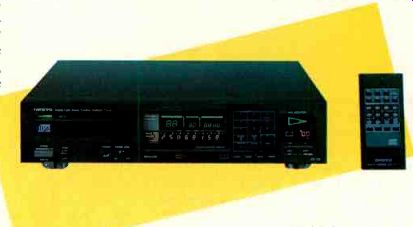
Onkyo's DX-150 can be programmed to play
up to sixteen tracks in any order. It also has skip search, block repeat,
and other functions. Double oversampling is said to insure optimal sound
quality. $400.
...highly susceptible even to slight nudges of the player and to bass sounds emanating from the loud speakers through which they are being played. Several companies have addressed themselves to the problem. Nakamichi, for instance, uses a "floating" drive system for its OMS-7 and OMS-5; the drive mechanism is mounted on a die cast base suspended on coil springs so as to float free of the main chassis. The system is said to make the players virtually impervious to external shock.
Kyocera's DA-810 uses a ceramic-base platform, a specially treated top cover, a specially constructed heat sink, and mechanical parts made of special alloys and ceramics in order to eliminate unwanted resonances and vibrations in its D/A converter system. JVC's XLV500 features an independent suspension system to isolate the laser pickups from shock and vibration for greater tracking accuracy. And Onkyo's Integra Series DX-200 features a special chassis construction, deadened with a newly developed material called Polysorb, that absorbs extraneous mechanical and external vibrations to prevent mistracking and to reduce microphone-induced distortion.
Subcodes
The Compact Disc can store more than just music. It can also store other types of digital information at the same time. For instance, in addition to music, a CD could encode graphic information that can be "played" on a video monitor linked to the player in an audio/video setup. Many of the third-generation CD players now or soon to be available have a subcode port for use with the coming generation of graphics-encoded Compact Discs.
Such ports are included in Sony's four regular players, the Technics SL-P3, the Pioneer PD-5010, PD-7010, and PD-9010, the Hitachi DA-4000, and the Sherwood CDP 200 and CDP-220, among others.
Special Features
Several of the new 1985 CD machines offer features beyond the usual. The Scott 949DA and 959DA, Nikko NCD-100, Sony CDP-650ESD, and Yamaha CD-3 are all capable of automatic play back with the use of an external audio timer. The rack-mountable Carver Compact Disc player incorporates a new switchable circuit called the Digital Time Lens; by compensating for left/right signal-content anomalies of CD's, the circuit is said to improve ambience, balance, and musicality. Sony's CDP-650ESD has switchable auto delay for a 2-second pause between selections as well as "shuffle play," a random track re-sequencing that rearranges song sequences on CD's "to add new interest to familiar discs," according to the company.
And the CDP-650ESD can stand alone as a high-quality CD player using its own integral digital-to-analog converter, or it can be used with a new outboard D/A converter, the DAS-702ES (about $1,500), as a "super-fidelity" player that can accommodate four different sampling frequencies.
------------------

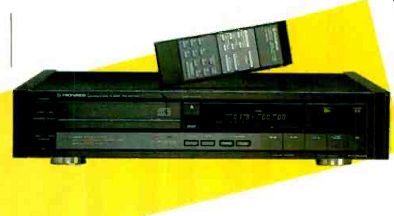
Quasar's CD-8975 is available in a metal cabinet ($400) or simulated
wood (shown, $425). It has fifteen-track random-access programming, skip
forward/back, program search, and index search.
----------------
The most unusual CD players in the 1985 lineup are a "double" player from Toshiba, the miniature home/portable player from Sony, and the combination CD/video disc players developed by Pioneer and sold by Pioneer, Teac, Luxman, and NAD. All these are quite likely to be significant influences on next year's CD hardware.

The Toshiba XR-V22 ($499.95) has two side-by-side disc drawers.
By loading two CD's in it, you can program up to thirty tracks from either disc or enjoy up to two hours of uninterrupted music if you play the discs sequentially; one disc can be changed while the other is playing. The XR-V22 also offers quick random access and automatic re peat, among other features.
---------------

Pioneer's PD-9010X, one of its Elite Series components, features full
random-access programming for up to thirty-two tracks, two-speed audible
scan, a digital filter, and wireless remote control. $540.
--------------------
Sony's $300 D-5, reviewed here last December, is still the "world's smallest CD player," measuring a mere 5 x 5 1/4 x 14 1/2 inches. The D-5 can be plugged into a home hi-fi system or used on the move with its optional battery-pack/carrying case and headphones. Its features include an Automatic Music Sensor for forward/back scanning, Music Search for high-speed previewing of disc content, and a basic time/battery-condition display.
Pioneer's CLD-900 ($1,200), reviewed in the February 1985 issue, was the world's first combination Compact Disc/LaserDisc player.
The front-loading player, with wire less remote control, has all the usual functions of both LaserDisc and CD players, including random access by frame and chapter search for video discs and track search, index search, scan, one-program selection repeat, and forward-skip selection for CD's.
The set automatically adjusts itself for the type of disc to be played. It also has an I/O port for connection to a personal computer.
The Luxman D-408 ($1,300), the Teac LV-5000VS ($1,300), and the NAD. 5900 ($1,200) are essentially the same as the Pioneer CLD-900.
These players are all made by Pioneer to the particular seller's specifications. (Trade reports indicate that Pioneer will manufacture still more versions of its combo player for marketing under additional major brand names.) At press time, many of the machines mentioned in this article were still being readied for full production. Consequently, you may find that the store models of some machines have more features than our advance news indicated.
While many of the newest models were scheduled for introduction in June at the Summer Consumer Electronics Show, not all will be available that soon. But you won't have long to wait now, and these remarkable machines are well worth waiting for.
====================
CD are here to stay (Jul, 1985)
DO ALL CD PLAYERS SOUND THE SAME? (Jan. 1986)
Source: Stereo Review (USA magazine)